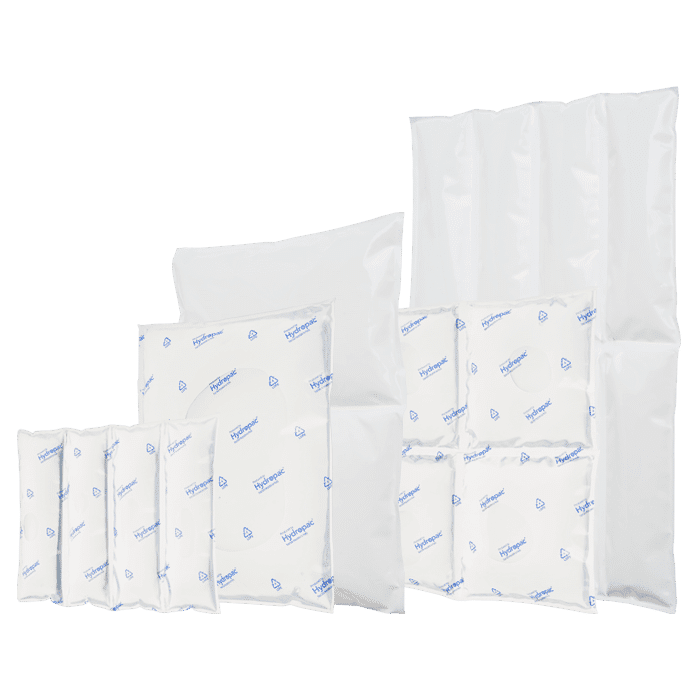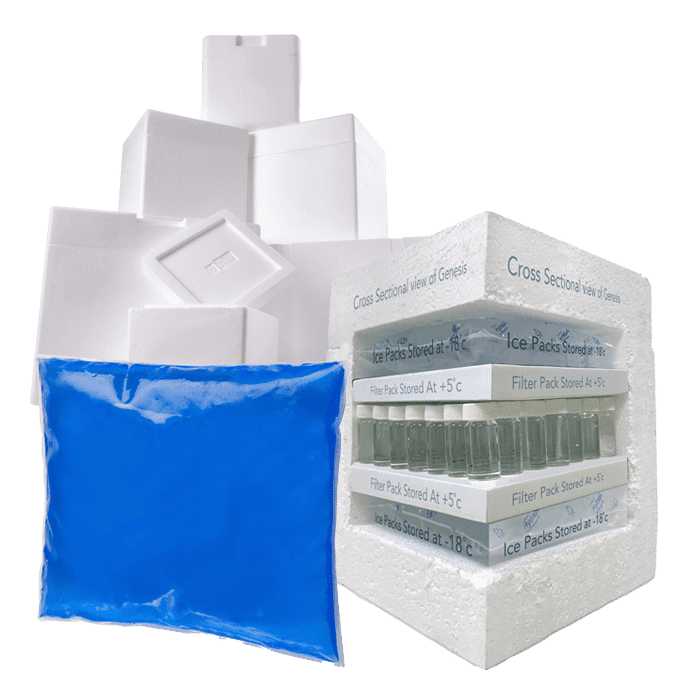FAQ of Frozen Food Shipping
Shipping frozen goods requires both specialist packaging and required coolants, as well as knowledge from the packaging team as to how to pack and insulate the goods inside correctly. This can be according to their desired shipping temperature, their make up (are they fragile for example?) and also the overall load of goods going into the box.
We frequently see people asking questions about frozen food shipping, so wanted to answer some of them here:
Custom chilled solutions for you
Hydropac offers every customer a customized solution for chilled and conditioned shipping. For example, we help a customer with limited freezing capacity to deliver gel packs frozen and ready to use, and we can manufacture almost all shapes and sizes of cooling elements. As a customer, you come first: we are here to help you.
Ideal frozen shipping temperatures of different goods
Most foods typically have a freezing point of between 0°C and -5°C depending on the water, sugar, fat, and salt content.
Frozen meats
Frozen meats, such as chicken, beef, turkey or pork, should be transported at a minimum of -15°C (or below).
Frozen Fish
The same applies to frozen lean and filleted fish; they should be kept at a minimum of 15°C. Frozen oily fish such as salmon or sardines can be transported at -18°C
Frozen Fruits & Vegetables
Frozen fruits and vegetables should be kept at a minimum of -15°C. It is worth noting that certain fruits and vegetables will exhibit colour changes after they are fully frozen; for example, broccoli will be an intense green on the bouquet, carrots will be very orange.
It should be noted that these it is also possible to “flash freeze” or “quick-freeze” products – in this case, the minimum temperature is -18°C.
There is generally a 3°C tolerance on this due to expected fluctuations in temperatures when transferring products from one place to another, so for quick-frozen products the minimum for a transfer period would be -15°C, and for all other frozen products -12°C. However, this lenience is not for extended periods of time in which the temperature goes above -15°C.
Even at temperatures between -5°C and -12°C, the risk and rate of microbial growth will be very minimal. It’s only when the product starts melting where it poses an issue.
Packaging frozen foods
When packaging frozen goods, there are a few good rules to follow:
- Use packaging designed to cope with cold/frozen temperatures – you need insulating materials on the inside, and durable on the outside.
- Waterproofing is key, especially if you are using ice packs as a coolant. If they burst, you want the goods to be protected from leakages (and you also want all goods to be protected against leakages from other items in the box). That being said, if you buy ice packs that can withstand extreme weights without leaking, waterproofing may become less of an issue (although any food packages containing liquid products such as juices or milk for example will still need to ensure protection against liquid damage is taken into consideration).
- It should also be noted that regular ice packs are not designed to protect frozen goods from melting – you need a specialist ice pack for frozen foods, such as HydroFreeze or EasiFreeze.
- As a rule, put the heaviest items on the bottom, to save crush damage in transit.
- Don’t overpack your boxes – packed products are heavy, ice packs are heavy, you don’t want the bottom of the box falling apart! It is important to use a box that is robust enough to take the combined weight of the coolants and the payload inside.
Maximum time frozen food should be in transit
The duration of time that frozen food can be in transit typically limited by how the goods are being kept frozen. Even if using a coolant like dry ice, which sits at around -77/78°C, it will melt (sublimate) over time and the temperature will start to warm up, so transit still needs to be as quick as possible to get the frozen goods delivered and into a proper freezer.
As a rule, we would recommend all frozen deliveries take place over no more than 48 hours, 36 at the very longest.
When can frozen foods be rejected by the end receiver?
Frozen foods can be rejected by the end receiver if there has been any spoilage or damage to the goods during transit. This is generally because of two primary problems:
- Temperature fluctuation, resulting in thawing or partial thawing of the goods. This can only occur if the product reaches its’ melting point – for most frozen products it’ll be between 0°C to -5° Below this temperature the product will be frozen solid.
- Damage to the foods or their packaging – usually a result of inadequate packaging.
Checking a Frozen Food Shipment before Accepting
If you are the end recipient and accepting frozen goods from a refrigerated vehicle, you need to check the frozen delivery carefully before accepting it. The main thing to check is the temperature of the storage compartment on the transit vehicle, and any records kept by the transporter, as it is essential that the temperature has not gone below the recommended frozen temps during transit.
You also need to check the individual boxes or pallets for exterior damage. If all OK, make sure to at least spot check the interior contents of several boxes, as again, you need to make sure there is no damage, leakages, contamination or warm temperatures.
If you are a home consumer accepting a frozen food delivery, then it’s your choice whether to accept the end product – if it feels frozen and solid, that is generally the best way to decide if a product has been kept frozen through transit.
How quickly should frozen food be stored once delivered?
A question for the end recipient, the answer is quite simply – “as soon as possible.” You need to ensure that the frozen temperature is maintained, so leaving it at room temperature or even chilled temperatures will be detrimental.
If you have any further questions, please don’t hesitate to give us a call on 01494 530182 or visit https://hydropac.co.uk/contact/ to use our contact form.
Sustainability Hydropac and CSR
Sustainability isn’t just a trend for us – it’s a promise. As we innovate, create, and lead, we keep our planet’s well-being at the forefront. With Hydropac, you’re not just preserving the quality of your cargo; you’re contributing to a healthier world.
Experience the power of sustainable temperature assurance with Hydropac – where excellence and environmental responsibility coexist for a brighter future.







